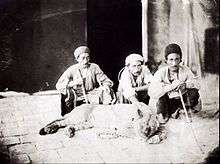Lake Parishan
| Designations | |
|---|---|
| Official name | Lake Parishan and Dasht-e-Arjan |
| Designated | 23 June 1975 |
| Reference no. | 37[1] |
Parishan Lake is a lake in Iran. The Parishan Lake is in Jereh and Baladeh District in Kazerun County, Fars Province and is the largest freshwater lake in the country.[3] It receives only very small amount of water from feeder rivers and the whole lake or wetland is a protected area, as it is considered a globally significant wetland ecosystem.[4]
The Protected Zone of Arzhan and Parishan
Another lake in this area is that of Arzhan.[5] The whole, protected area is called "Arzhan National Park."[6][7] This area is an important sanctuary for birds.[3][4]
Project Lion

In the past, the Persian lion used to occur in this place, besides other parts of Iran. Nowadays, in the wilderness of Eurasia, the only members of this race of lions occur in and around Gir Forest, in Kathiawar Peninsula, India.[8][9] There was a plan to bring in Gir lions during 1977, but there were issues, and it did not get fulfilled. This area includes the village of Arzhan, and is of agricultural importance, and bringing in lions would mean setting aside farmland, and settling farmers elsewhere.[6][7] This happens to be a reason why it is difficult to reintroduce lions from Gir Forest to another place within India.[10] Nevertheless, Iran's intention to restore its population of lions would continue into the 21st century.[11][12]
See also
References
- ↑ "Lake Parishan and Dasht-e-Arjan". Ramsar Sites Information Service. Retrieved 25 April 2018.
- ↑ "UNESCO Biosphere Reserve Directory".
- 1 2 "Dasht-e Arjan and Lake Parishan (Important Birds Areas of Iran, Islamic Republic of)". BirdLife International. Retrieved 2010-09-08.
- 1 2 "Iranian Wetlands Conservation Project - Lake Urmia and Lake Parishan - Wildfowl & Wetlands Trust (WWT)". WWT. Archived from the original on 2010-12-05. Retrieved 2010-09-08.
- ↑ FARS Geography and History
- 1 2 Humphreys, P., Kahrom, E. (1999). Lion and Gazelle: The Mammals and Birds of Iran. Images Publishing, Avon.
- 1 2 Firouz, E. (2005). The complete fauna of Iran. I. B. Tauris. pp. 5–67. ISBN 978-1-85043-946-2.
- ↑ Geptner, V. G., Sludskij, A. A. (1972). Mlekopitajuščie Sovetskogo Soiuza. Vysšaia Škola, Moskva. (In Russian; English translation: Heptner, V.G., Sludskii, A. A., Komarov, A., Komorov, N.; Hoffmann, R. S. (1992). Mammals of the Soviet Union. Vol III: Carnivores (Feloidea). Smithsonian Institution and the National Science Foundation, Washington DC).
- ↑ Singh, H. S.; Gibson, L. (2011). "A conservation success story in the otherwise dire megafauna extinction crisis: The Asiatic lion (Panthera leo persica) of Gir forest" (PDF). Biological Conservation. 144 (5): 1753–1757. doi:10.1016/j.biocon.2011.02.009.
- ↑ Johnsingh, A.J.T. (2006). "Kuno Wildlife Sanctuary ready to play second home to Asiatic lions?". Field Days: A Naturalist's Journey Through South and Southeast Asia. Hyderabad: Universities Press. pp. 126–138. ISBN 8173715521.
- ↑ Dey, A. (2009-07-16). "Rajasthan to be home for cheetahs". Times of India. Retrieved 2009-08-09.
- ↑ Khosravifard, S. (22 May 2010). "Russia, Iran exchange tigers for leopards but some experts express doubts". Payvand News. Retrieved 6 August 2011.
